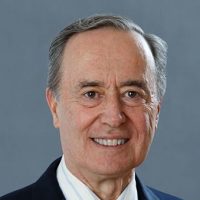Featured Expert:

Nicholas Chiorazzi, MD
Head, Karches Center for Oncology Research
Feinstein Institutes for Medical Research
Dr. Nicholas Chiorazzi highlights the critical role of the CLL Global Research Foundation in driving CLL research and treatment forward. Dr. Chiorazzi recounts how his longstanding relationship with Dr. Michael Keating has shaped his approach to studying CLL and emphasizing the critical role of the foundation in accelerating the path toward a cure.
Transcript
Dr. Nicholas Chiorazzi:
I met Dr. Keating now probably about 20, 25 years ago. I was relatively new to the field of CLL. My background is as a rheumatologist, somebody who studies rheumatic diseases, autoimmunity. And we had done some experiments in Chronic Lymphocytic Leukemia that allowed me to attend a meeting on CLL at which all the important players were. And Michael, Dr. Keating, was certainly a key player there. I felt very much out of place. I was not a young person at the time, but young in the field and really didn’t know anybody. And he went out of his way to be like he is, which is really a caring person who really cares about people, not only patients, but even other people who are probably uncomfortable. It was wonderful. I left that thinking that this is one of the greatest fields to study because if you have somebody like that in the field, it must be wonderful.
I’ve been fortunate enough to come down to MD Anderson a couple of times and speak with Dr. Keating and others at MD Anderson, Dr. Weirda, Dr. Gandhi and so on. Again, knowing my background is not in hematology but is in a different field, the ability to talk to people who know CLL much better, at the clinical level, than I did was really very important for me. And it certainly helped to shape the kinds of questions that I asked, experimentally, about CLL.
The reason is we have to find a cure, and we are probably close to curing some people, but the fact is that many of the people who we think that we are on the way to curing, we find out that they relapse. It’s a shame to have made such progress but not really gone to the final touchdown, if you will, to stop because it looks like things have gotten much better. The reality is we’re really close to hitting that long home run and we really should hit the grand slam, we shouldn’t stop at a home run with nobody on base, essentially. I think it’s really critical, and this is something that’s happened in the past also. The history of myeloid leukemia’s is very similar to CLL. There were major breakthroughs in the therapy for myeloid leukemia and at that point in time people dropped the ball. And people who were putting money into the study dropped the ball and it put them behind and then they recovered again. And I think it’s the same thing here. We’ve made significant progress, we can’t stop. We have to finish.
I would like to congratulate Dr. Keating for what he’s done as a medical scientist for sure. But from the standpoint of the CLLGRF, I think for people who are not familiar with medical research, the idea that somebody should create a foundation based on philanthropy at one institution and share that money internationally, I think is really amazing. It would not be surprising for me for 99% of the rest of the population for have been able to collect, solicit, get money from philanthropists to study something and all of that money would’ve stayed in-house. That is not the way it is at the CLLGRF and it’s all because of Michael.

